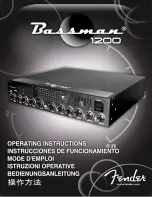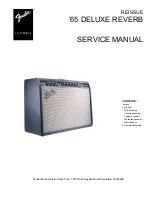
Power-Tech Series Power Amplifiers
Page 11
Reference Manual
4 Specifications
The following applies to units in Stereo mode with 8-ohm loads and an
input sensitivity of 26 dB unless otherwise specified.
Standard 1 kHz Power:
refers to maximum average power in watts at
1 kHz with 0.1% THD.
Full Bandwidth Power:
refers to maximum average power in watts
from 20 Hz to 20 kHz with 0.1% THD.
120 VAC, 60 Hz Units:
refers to amplifiers with dedicated transformers
for 120 VAC, 60 Hz power mains.
International Units:
refers to amplifiers with special multi-tap
transformers that make them configurable for several AC mains
voltages and line frequencies.
Performance
Frequency Response:
±0.1 dB from 20 Hz to 20 kHz at
1 watt.
Phase Response:
±10 degrees from 10 Hz to 20 kHz at
1 watt.
Signal-to-Noise:
A-weighted, better than 105 dB below
full bandwidth power. Better than 100 dB below full
bandwidth power from 20 Hz to 20 kHz.
Total Harmonic Distortion (THD):
Less than 0.05% at
full bandwidth power from 20 Hz to 1 kHz increasing
linearly to 0.1% at 20 kHz.
Intermodulation Distortion (IMD):
(60 Hz and 7 kHz
4:1) Less than 0.05% from less than 171 milliwatts to full
bandwidth power.
Damping Factor:
Greater than 1,000 from 10 Hz to
400 Hz.
Crosstalk
Power-Tech 1: Greater than 75 dB below full bandwidth
power from 50 Hz to 2 kHz, rising linearly to greater than
60 dB at 20 kHz.
Power-Tech 2: Greater than 90 dB below full bandwidth
power from 50 Hz to 2 kHz, rising linearly to greater than
66 dB at 20 kHz.
Power-Tech 3: Greater than 90 dB below full bandwidth
power from 50 Hz to 4 kHz, rising linearly to greater than
70 dB at 20 kHz.
Controlled Slew Rate:
Greater than 13 volts/ms.
Voltage Gain:
20:1 ±3% or 26 dB ±0.25 dB at the
maximum level setting.
Power-Tech 1: 54:1 ±12% or 35 dB ±0.5 dB at 0.775-volt
sensitivity; 30:1 ±12% or 30 dB ±1 dB at 1.4-volt
sensitivity.
Power-Tech 2: 66:1 ±12% or 36 dB ±0.5 dB at 0.775-volt
sensitivity; 36:1 ±12% or 31 dB ±1 dB at 1.4-volt
sensitivity.
Power-Tech 3: 84:1 ±12% or 38 dB ±0.5 dB at 0.775-volt
sensitivity; 46:1 ±12% or 33 dB ±1 dB at 1.4-volt
sensitivity.
Power
Output Power:
The following specifications are
guaranteed minimums for standard 1 kHz power from
120 VAC, 60 Hz North American units. For
international power specifications see the matrices that
follow.
Power-Tech 1
Stereo mode (both channels driven):
305
watts into 4 ohms.
220
watts into 8 ohms.
Bridge-Mono mode:
605
watts into 8 ohms.
445
watts into 16 ohms.
Parallel-Mono mode:
605
watts into 2 ohms.
440
watts into 4 ohms.
Power-Tech 2
Stereo mode (both channels driven):
460
watts into 4 ohms.
325
watts into 8 ohms.
Bridge-Mono mode:
910
watts into 8 ohms.
660
watts into 16 ohms.
Parallel-Mono mode:
920
watts into 2 ohms.
655
watts into 4 ohms.
Power-Tech 3
Stereo mode (both channels driven):
760
watts into 4 ohms.
540
watts into 8 ohms.
Bridge-Mono mode:
1,525
watts into 8 ohms.
1,090
watts into 16 ohms.
Parallel-Mono mode:
1,530
watts into 2 ohms.
1,080
watts into 4 ohms.
Load Impedance:
Safe with all types of loads. Rated for
4 to 8 ohms in Stereo, 8 to 16 ohms in Bridge-Mono and 2
to 4 ohms in Parallel-Mono mode.
Required AC Mains:
Power requirements are provided
on each unit’s back panel. 120 VAC, 60 Hz and 100/120/
220/240 VAC, 50 to 60 Hz (unconvertible) units are
available. Rated AC mains voltages are ±10%.
Quiescent power draw is 90 watts or less.
Power-Tech 1: 100 and 120 VAC units draw up to 6
amps of current; 220 and 240 VAC units draw up to 3
amps.
Power-Tech 2: 100 and 120 VAC units draw up to 10
amps of current; 220 and 240 VAC units draw up to 5
amps.
Power-Tech 3: 100 and 120 VAC units draw up to 15
amps of current; 220 and 240 VAC units draw up to 7
amps.





































